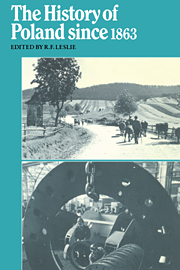Book contents
- Frontmatter
- Contents
- List of maps
- Preface to the paperback edition
- Abbreviations
- Map 1 Poland in the nineteenth century
- 1 Triloyalism and the national revival
- 2 Poland and the crisis of 1900–7
- 3 Poland on the eve of the First World War
- 4 The emergence of an independent Polish state
- 5 The breakdown of parliamentary government
- 6 Piłsudski in power, 1926–35
- 7 Poland without Piłsudski
- 8 Poland in defeat, September 1939–July 1941
- 9 The ill-fated alliance, August 1941–April 1943
- 10 The years of Tempest, May 1943–December 1944
- 11 Post-war Poland
- 12 The rise and ebb of stalinism
- 13 The October turning point
- 14 ‘The little stabilization’
- 15 The decline of Gomułka
- 16 Poland under Gierek
- 17 Polish society, 1945–75
- Epilogue: The rise and fall of Solidarity
- Notes
- Select bibliography
- Index
17 - Polish society, 1945–75
Published online by Cambridge University Press: 26 December 2009
- Frontmatter
- Contents
- List of maps
- Preface to the paperback edition
- Abbreviations
- Map 1 Poland in the nineteenth century
- 1 Triloyalism and the national revival
- 2 Poland and the crisis of 1900–7
- 3 Poland on the eve of the First World War
- 4 The emergence of an independent Polish state
- 5 The breakdown of parliamentary government
- 6 Piłsudski in power, 1926–35
- 7 Poland without Piłsudski
- 8 Poland in defeat, September 1939–July 1941
- 9 The ill-fated alliance, August 1941–April 1943
- 10 The years of Tempest, May 1943–December 1944
- 11 Post-war Poland
- 12 The rise and ebb of stalinism
- 13 The October turning point
- 14 ‘The little stabilization’
- 15 The decline of Gomułka
- 16 Poland under Gierek
- 17 Polish society, 1945–75
- Epilogue: The rise and fall of Solidarity
- Notes
- Select bibliography
- Index
Summary
The problems of Poland's political and economic life should not obscure the fact that profound changes have occurred in Polish society. The period of most rapid change took place during the Six Year Plan, especially in the years 1951–3, when Poland was under the influence of Stalinism. Thereafter social change was less dramatic. The Poland which emerged from the Second World War was substantially different from the Poland of 1939. According to the census of 1931, the population amounted to 32,107,000, which rose by the end of 1938 to 34,849,000. On 14 February 1946, when the first post-war census was carried out, the population within the new frontiers was 23,930,000. The area covered by the Polish state had fallen from the 388,600 sq. km of 1938 to 311,700 sq. km as a result of the loss of 179,700 sq. km in the east and the gain of 102,800 sq. km in the north and west. The 1946 census showed that the population consisted of 20,520,000 Poles, 2,288,000 Germans, 390,600 persons of other nationalities and 417,000 whose nationality was said to be ‘in the course of verification’. During the years 1946–9 virtually all the Germans were expelled from the north and west, with the result that native Poles became the overwhelming majority of the population. Over 1 million so-called ‘ autochthons’ of Polish or Slav descent, who had to some extent been Germanized, remained behind in the new territories. After 1956 and again after 1971 many of them were allowed to emigrate to Germany to join their relatives.
- Type
- Chapter
- Information
- The History of Poland Since 1863 , pp. 444 - 457Publisher: Cambridge University PressPrint publication year: 1980
- 1
- Cited by



